How To Change Decimals Into Mixed Numbers
Learning how to convert from a decimal to a mixed number isn't just busy work. Depending on what sort of mathematical operations you're performing, having all your numbers in one form or the other can make things much easier. And sometimes, giving an answer in one form or the other simply makes much more sense. For example, if someone told you that a box was 0.92 feet long, that might not tell you much – but if they said it was 11/12 feet long (which could be read as 11 inches), that would be a lot easier to digest.
A Quick Review of Mixed Numbers
A Quick Review of Mixed Numbers
Before you get down to the nitty-gritty of converting decimals to mixed numbers, take time for a quick review of mixed numbers. They consist of two parts: A non-zero integer, which makes up the whole-number part of the mixed number; and a non-zero fraction, which completes the mixed number. Note that the fraction should be "proper," which means the numerator (the number on top) is smaller than the denominator (the number on the bottom).
First, Identify the Whole Number
First, Identify the Whole Number
The easiest part of this operation is identifying the whole-number part of your mixed number. That's anything to the left of the decimal point. Write this down as part of your answer, and then leave a space to the right of it where you'll fill in the fraction later.
Next, Convert the Decimal to a Fraction
Next, Convert the Decimal to a Fraction
Now comes the challenging part: Turning everything to the right of the decimal point into a fraction. Pull out a piece of scratch paper and write down whatever numbers are to the right of the decimal point as the top number, or numerator, in a fraction. Don't include the decimal point.
What is the denominator (bottom number) of this fraction? There are two ways to figure that out. If you know the names of the place values to the decimal point, you simply fill in the number that represents the place value farthest to the right. A couple of examples will help make this clear:
**Example 1:** Convert 0.9 to fraction form.
You already know the numerator of your fraction will be anything to the right of the decimal – which in this case is 9. The number farthest to the right (also the "9") is in the tenths place, so the denominator of the fraction will be 10, giving you an answer of:
9/10
**Example 2:** Convert 0.325 to fraction form.
The numerator of your fraction will be 325 (everything to the right of the decimal point). The denominator is the name of the place value farthest to the right. In this case that's the thousandth place, which is occupied by the "5." So the denominator is 1000, which gives you the fraction:
325/1000
The Other Method
The Other Method
If you don't know the name of the place value farthest to the right in your decimal, or if it's such a big number that it becomes unwieldy, there's another way of finding the denominator for your mixed number: Just count the number of places to the right of the decimal point. The denominator will be 10**x**, where x is the number of places you counted. Or, to put it another way, it'll be 1 followed by however many places you counted.
Take a look at the two examples already given: When 0.9 becomes 9/10, there's just one number to the right of the decimal point, and so there's one zero in the denominator. When 0.325 becomes 325/1000, there are three numbers to the right of the decimal point, so there are three zeroes in the denominator.
But Wait, There's More
But Wait, There's More
Now you have a mixed number. But in many cases, you'll have to perform one more step: Rendering that mixed number in simplest form. All that means is reducing the fraction part of it to simplest or lowest terms, which you do by canceling any common factors that appear in both the numerator and the denominator. Here are a couple of examples:
**Example 1:** Convert 3 5/10 to simplest terms.
5 is a common factor in both the numerator and denominator. When you cancel 5 from each place, you have 3 1/2. There are no more common factors that don't equal one, so this is your mixed number in simplest form.
**Example 2:** Convert 3 4/12 to simplest terms.
Did you spot the common factor that appears in both the numerator and the denominator? It's 4 – and after you cancel it from both parts of the fraction, there are no other common factors to eliminate. So you're left with the mixed number in lowest terms:
3 1/3
Cite This Article
MLA
Maloney, Lisa. "How To Change Decimals Into Mixed Numbers" sciencing.com, https://www.sciencing.com/change-decimals-mixed-numbers-8081676/. 29 October 2018.
APA
Maloney, Lisa. (2018, October 29). How To Change Decimals Into Mixed Numbers. sciencing.com. Retrieved from https://www.sciencing.com/change-decimals-mixed-numbers-8081676/
Chicago
Maloney, Lisa. How To Change Decimals Into Mixed Numbers last modified August 30, 2022. https://www.sciencing.com/change-decimals-mixed-numbers-8081676/
